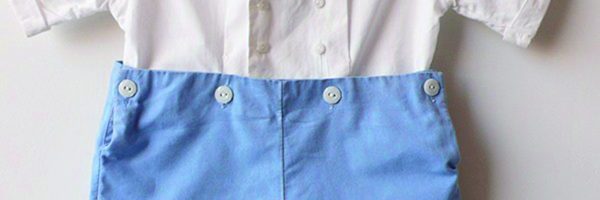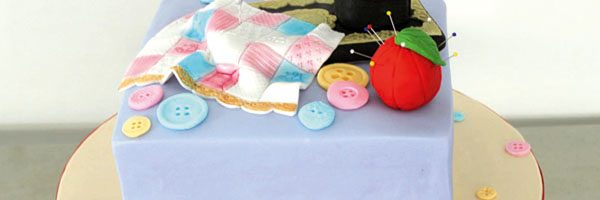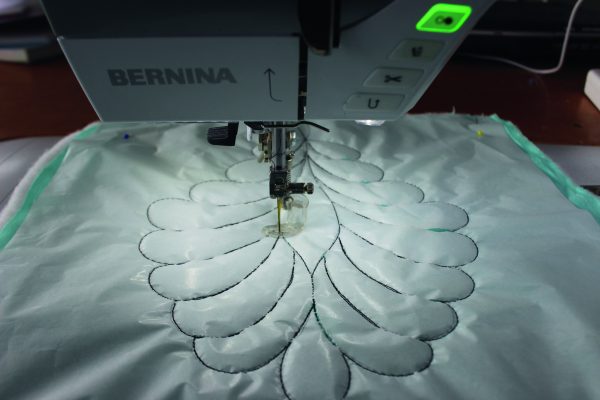
Quilting Advice from Deborah Louie: Open Feathers
Feathers, with a little practice and time, are a beautiful addition to your quilting repertoire. They add elegance to your quilts, and who doesn’t like the look of feather quilting on a project?
What I really love about the open feather is that it is very quick to quilt. It suits both contemporary and traditional styles and is a very versatile design. The open feather, as the name implies, has space between each plume and requires no backtracking to complete the basic design. However, I will take this basic design and demonstrate how to make new designs from one simple stencil.
All the quilting I will be showing you in this article is with the free-motion technique. To set up your machine, use an open toe, free-motion foot, feed dogs disengaged and stitch length of 0. Set the machine on slow to medium speed if you can adjust machine speed. Mostly I have used a 50-weight cotton thread in the top and in the bobbin. If you have not done this style of quilting before, perhaps get some scrap fabric and batting to practise on for a while, gliding the fabric smoothly while the needle is moving.

Quilting feathers using the same colour thread as the fabric is very appealing. Not only does it look sensational, but it is a little easier, too, as the matching colour is more forgiving of the quilted shapes. Maybe leave sharp, contrast colour thread work until you feel very comfortable with quilting feathers. If you quilt on busy, printed fabrics, the whole feather effect is lost. Low contrast, colour-on-colour prints and solids are ideal to highlight your quilting.
Learn how to create a landscape quilt
Quilting Options for the Open Feather
On this yellow sample I have used a simple 1 1/2in plastic open feather sashing/border stencil. Very simple, no spine at all, just the same-size shapes repeating again and again. It is a great choice for a first feather design. It would fit into a 2in sashing or border very nicely, leaving a 1/4in breathing space both sides.
This is the simple 1 1/2in open feather stencil used as the basis for the quilting designs in this article.
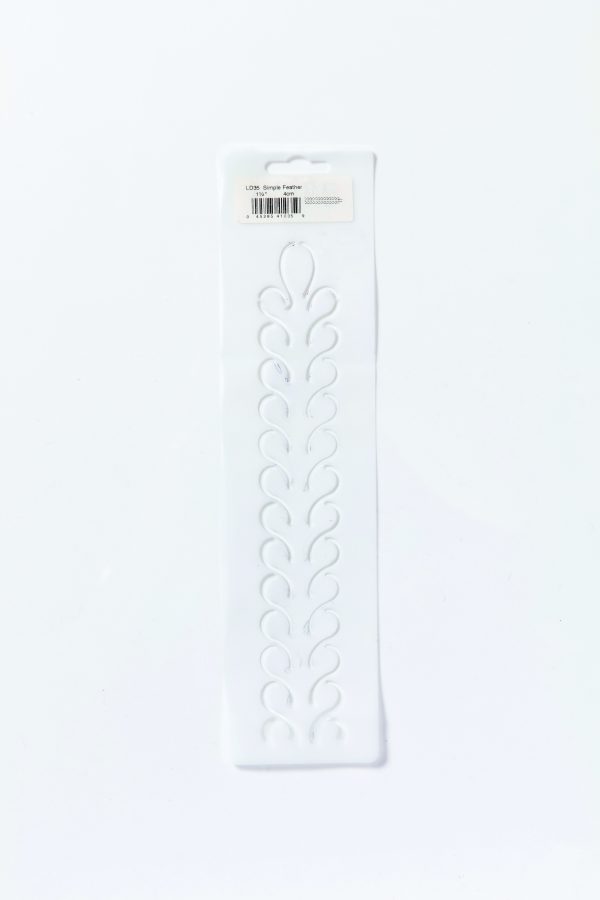
Sample 1
I have marked the fabric first with an F pencil, or you could use a wash-away or fade-away pen. I then worked one feather shape at a time, stopping after each plume, with my needle down. This places you at the right place to start the next feather plume shape underneath. You can stitch from the top, all the way down to the bottom. Stopping after each plume allows you to move your hands to the correct position before you start the next shape. Once the plumes down one side are complete, cut threads at the bottom

Sample 2
Bring your needle back to the top and start on the second side of the feather. Work all the way down again, using the same technique as before. At first it might be a little shaky, but please persevere. You can stitch the same design over and over on your sample until you start to feel more relaxed and the plumes look good. Sample 1 and Sample 2 are down feathers, that is, the direction of the plumes heads towards the bottom of the direction that we are quilting. We therefore stitch in a downwards direction.

Sample 3
This is a travelling up feather. Unlike Sample 1 and Sample 2, the feather plumes head in an upward direction on the fabric. For this design I stitched from the bottom to the top. I used the same basic technique of stopping, but added a little curl, which is fun. The point of the change of direction in the little curl was the perfect place to stop and reposition for the next plume. The un-quilted section shows the original shape of the stencil that I have used to create the new shape.

Sample 4
This feather is a continuous design. I stitched down the sample, alternately stitching left, then right, then left, then right etc all the way down. It links the two sides of the feather — there is no open space in the middle of this design. Stitching both sides at the same time makes this a very fast design to quilt.

Learn fabric and painted appliqué finished with free-motion machine quilting!
Sample 5
I drew and stitched only one side of the feather. The black line represents a possible seam of a small border. This sample also shows turning the corner for this half feather. It is the prefect design for narrow borders.
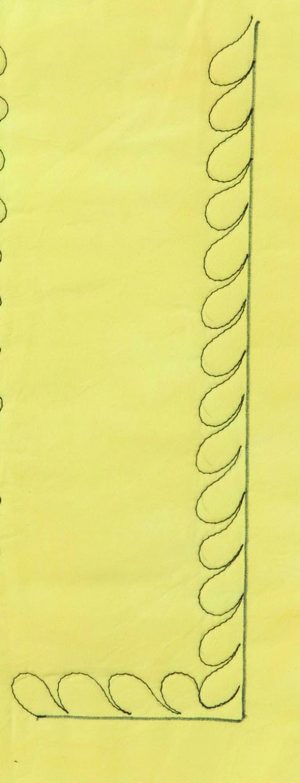
Sample 6
I added a curved spine to the design, drawing it in after I traced the feathers on the stencil. I stitched the spine first from the top to the bottom, cut threads, then stitched again top to bottom on one side of the feathers, then echo quilted back up to the top. I was then able to stitch the feathers on the second side, but this time I changed it up a little, free-forming some different-sized shapes, before I echo quilted back to the top.

Sample 7
I did not use a stencil for this final sample. I stitched the curved spine on the left first from top to bottom, feathered up with assorted sizes, then stitched the curved spine back down, leaving an 1/8in gap. This allowed me to travel back up again, no need to end off at all, with fully continuous stitching. This has a delightful flow to it. This type of design will become easier for you once you have quilted a few feathers and are familiar with the flow and shape of the plumes. As the plumes are different sizes, it would look fantastic on a contemporary quilt design.
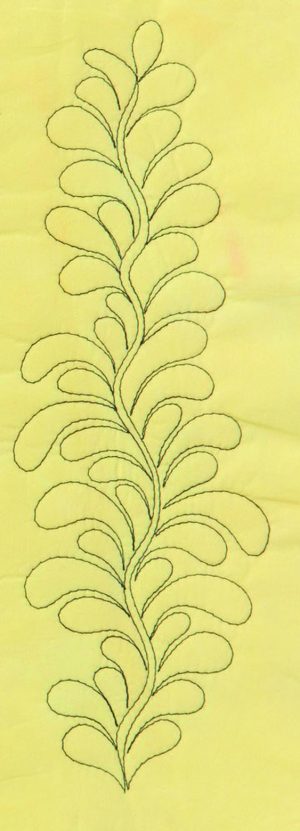
Sample 8
Sometimes I use the stencils as the starting point when designing new quilting motifs for a certain project. For the design below, I have used the original 1 1/2in open feather stencil. By repeating the shapes in an eight-point formation, the feathers now look like a snow flake. This design would work very nicely in an 8in block, perhaps a winter theme quilt, and the 1 1/2in strip version of the open feather in the sashing. They would complement each other very nicely in the quilt.
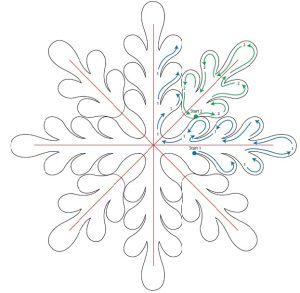
The simple stencil is repeated to form a new block design. It can be quilted continuously, following the arrows. Quilt Line #1 first, stopping at the intersection of Line #2, then quilt the next feather. This brings you back on Line #1 again to continue on with the rest of the design.
Learn how to make a new york beauty block with foundation piecing
Any form of free-motion quilting gets easier with practice. The quilting stencils that are available will vary. Adapt the techniques that I have used in this article to your stencil and feather design, and allow yourself to play. If you would like to know more about free-motion quilting or online workshops, visit my website: www.deborahlouie.com.au
Happy Quilting
X Deb

